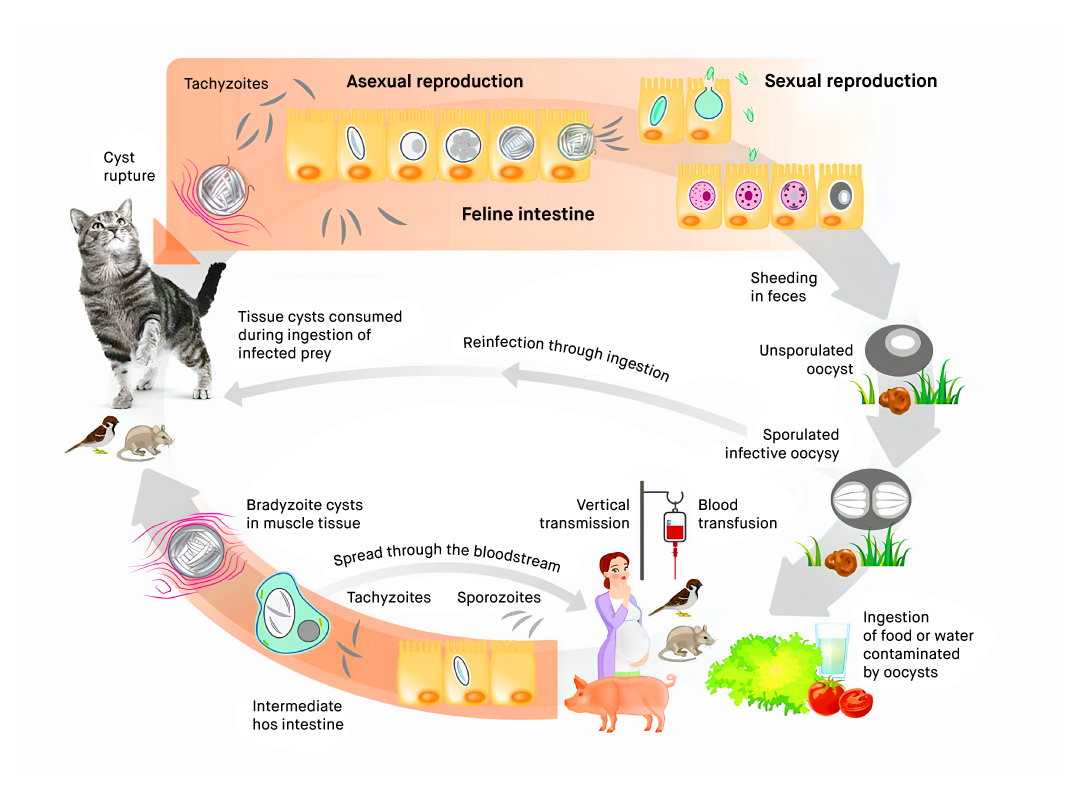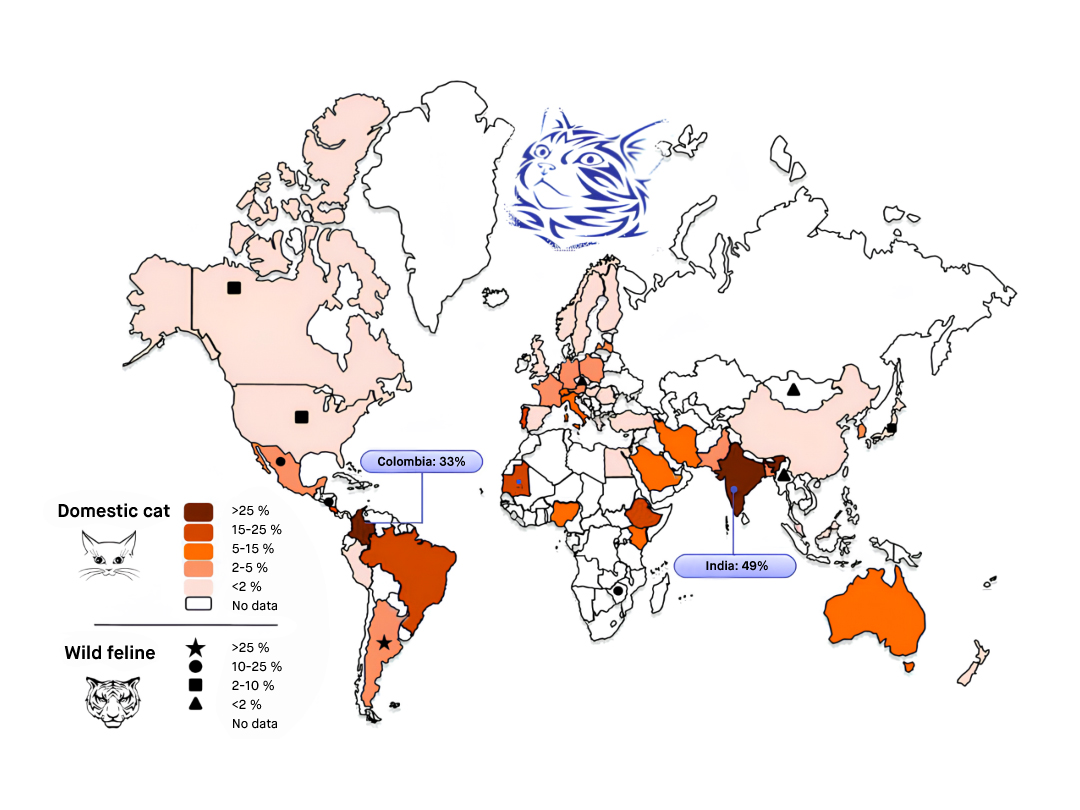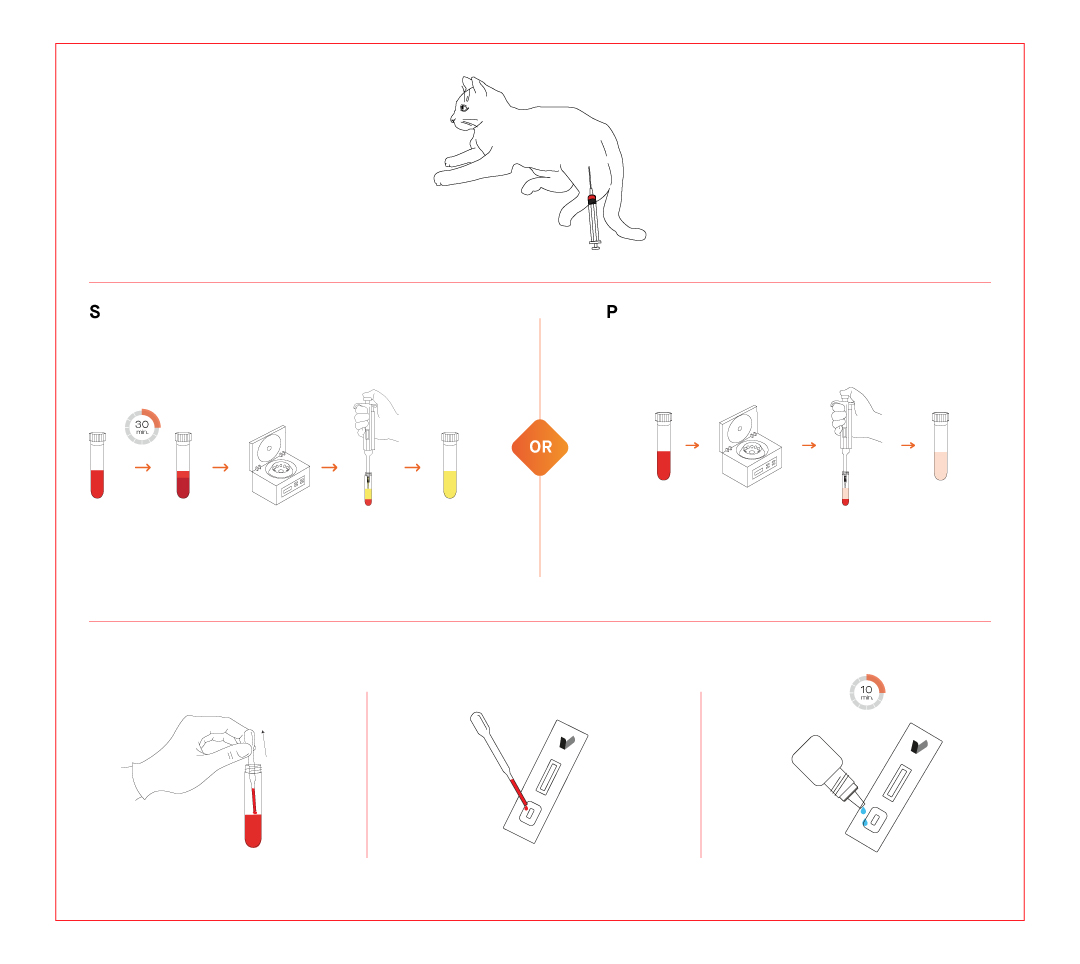Toxoplasma gondii, a microscopic parasite, has long fascinated scientists and pet owners alike due to its intricate life cycle and its potential impact on both human and feline health. In this blog, we delve into the world of this enigmatic organism, exploring its characteristics, transmission, and the disease it causes in cats—Toxoplasmosis.
Understanding Toxoplasma gondii:
Toxoplasma gondii is a single-celled parasite belonging to the phylum Apicomplexa. It exhibits a complex life cycle involving different hosts, with cats being the definitive host where sexual reproduction of the parasite occurs. However, its influence extends far beyond the feline realm, as it can infect a wide range of warm-blooded animals, including humans.
Life Cycle:
The life cycle of Toxoplasma gondii is intricately woven, involving both sexual and asexual stages. In its definitive host, the cat, the parasite undergoes sexual reproduction, producing oocysts that are shed in the feces. These oocysts can survive in the environment for extended periods, posing a risk of infection to other animals, including intermediate hosts such as rodents and birds.

Figure 1: Life cycle of the Toxoplasma gondii
Upon ingestion by an intermediate host, the oocysts transform into tachyzoites, rapidly multiplying forms of the parasite that can disseminate throughout the host’s body. Within the tissues of the intermediate host, including muscle and brain tissue, the tachyzoites form cysts, where they can persist for the life of the host. If a cat preys on an infected intermediate host, the cycle begins anew as the cat becomes infected by ingesting tissue cysts containing bradyzoites, another form of the parasite.
How is Toxoplasma Transmitted?
Toxoplasma gondii, the parasite responsible for causing toxoplasmosis, can be transmitted through several routes:
- Ingestion of Contaminated Food or Water: Consuming raw or undercooked meat from animals infected with Toxoplasma gondii is a common mode of transmission. Additionally, fruits and vegetables contaminated with oocysts from cat feces or soil can also transmit the parasite if consumed without proper washing.
- Handling Cat Litter: Cleaning cat litter boxes can expose individuals to Toxoplasma gondii oocysts if the cat has been shedding them in its feces. Direct contact with contaminated litter or inadvertent ingestion after handling contaminated objects without proper hand hygiene can lead to infection.
- Transplacental Transmission: Pregnant women who become infected with Toxoplasma gondii for the first time during pregnancy can transmit the parasite to the fetus through the placenta, leading to congenital toxoplasmosis. This route of transmission can result in severe complications for the unborn child.
- Organ Transplantation or Blood Transfusion: In rare cases, Toxoplasma gondii can be transmitted through organ transplantation or blood transfusion from an infected donor to a recipient. This mode of transmission is uncommon but highlights the importance of screening donors and implementing appropriate safety measures.
- Inhalation of Aerosolized Oocysts: While less common, inhalation of aerosolized oocysts from contaminated soil or cat feces can also lead to infection, particularly in individuals who work with soil or handle infected animals.
Toxoplasmosis in Cats:
Toxoplasmosis, the disease caused by Toxoplasma gondii, can manifest differently in cats depending on various factors such as the age and immune status of the animal. In healthy adult cats, the infection may be asymptomatic or cause mild symptoms such as lethargy, fever, and respiratory issues.
However, in kittens or cats with weakened immune systems, toxoplasmosis can lead to more severe symptoms, including neurological signs such as tremors, seizures, and paralysis.
Prevalence of Toxoplasma in Cats
The prevalence of Toxoplasma gondii infection in cats varies widely depending on factors such as geographic location, outdoor access, and population density. Studies have reported prevalence rates ranging from 6% to 80% in different regions. Outdoor cats with access to hunting and prey animals tend to have higher rates of infection, while indoor-only cats generally have lower rates. Climate, population density, and management practices also influence prevalence.

Figure 2: The prevalence of Toxoplasma gondii infection.
Human Health Implications:
While cats serve as the definitive host for Toxoplasma gondii, humans can also become infected through ingestion of contaminated food or water, or by handling cat litter contaminated with oocysts. In most healthy individuals, the infection may cause mild flu-like symptoms or go unnoticed. However, it can pose serious risks to pregnant women and individuals with compromised immune systems, potentially leading to severe complications such as miscarriage, stillbirth, or neurological disorders.
How to Prevent Feline Toxoplasmosis?
Preventing feline toxoplasmosis involves several measures aimed at reducing the risk of infection in cats and minimizing the transmission of Toxoplasma gondii to other animals and humans. Here are some key preventive measures:
- Keep Cats Indoors
- Feed Commercially Prepared Food
- Prevent Hunting
- Practice Good Litter Box Hygiene
- Avoid Contaminated Soil
- Keep Cats Away from Wildlife
- Prevent Transplacental Transmission
- Practice Good Hygiene
- Screen Donated Blood and Organs
Treatment for Feline Toxoplasmosis
Treatment for feline toxoplasmosis typically involves medication, such as clindamycin, along with supportive care including fluids and nutritional support. Monitoring the feline’s situation closely is essential, and following the precautions to prevent transmission to other animals and humans is crucial. Consulting a vet for diagnosis and treatment is important for the cat’s health and recovery. Early intervention improves the prognosis for cats with toxoplasmosis.
How to Use Feline Toxoplasma Rapid Test Kit?
Using a feline toxoplasma rapid test kit typically involves the following steps:
1. Read the Instructions: Carefully read the instructions provided with the rapid test kit before starting the procedure. Ensure you understand the testing process and any precautions that need to be taken.
2. Prepare the Sample: Obtain a fresh sample from the cat, such as blood, serum, plasma, or feces, as specified in the test kit instructions. Follow proper sample collection and handling procedures to ensure accurate test results.
3. Prepare the Test Kit: Open the test kit package and remove the components, including the test device, sample diluent or buffer, and any other required materials.
4. Apply the Sample: Using a dropper or provided pipette, add the specified volume of sample (e.g., serum, plasma, or diluted fecal extract) into the sample well or test cassette as indicated in the instructions. Ensure that the sample is applied correctly to avoid contamination or spillage.

Figure 3: How to use the Feline Toxoplasma Rapid Test Kit
5. Wait for Results: Allow the test device to develop for the specified period, typically a few minutes, as indicated in the instructions.
6. Interpret Results: After the specified development time, observe the test device for the appearance of colored lines or other indicators. Control line (C) to verify the test’s validity and a test line (T) that appears if Toxoplasma-specific antigens or antibodies are present in the sample.
7. Record Results: Record the test results as either positive, negative, or invalid, based on the appearance or absence of colored lines on the test device.
8. Documentation and Reporting: Document the test results, including the cat’s identification information, sample type, test outcome, and any relevant clinical details. Report the results to the appropriate veterinary personnel or healthcare provider as necessary.
It’s essential to follow the manufacturer’s instructions precisely to obtain reliable and accurate results with the feline toxoplasma rapid test kit.
What are the Most Commonly Used Diagnosis Kits for Toxoplasmosis in Cats?
The Toxo Rapid Antibody Test Kit provides a quick and accurate method for detecting Toxoplasma gondii antibodies in serum and plasma samples from both cats and dogs. Its user-friendly design, coupled with visually interpretable results, simplifies the diagnostic process for veterinarians. With rapid outcomes available within minutes, this portable tool facilitates timely diagnosis and treatment decisions, enhancing overall veterinary care for feline and canine patients.
REFERENCES
- Centers for Disease Control and Prevention. (2023a, June 9). CDC – toxoplasmosis. Centers for Disease Control and Prevention. https://www.cdc.gov/parasites/toxoplasmosis/
- Attias, M., Teixeira, D.E., Benchimol, M. et al.The life cycle of Toxoplasma gondii was reviewed using animations. Parasites Vectors 13, 588 (2020). https://doi.org/10.1186/s13071-020-04445-z
- Molaei, S., Dadkhah, M., & Fathi, F. (2023). Toxoplasmosis diagnostic techniques: Current developed methods and biosensors. Talanta, 252, 123828.
- Hatam-Nahavandi, K., Calero-Bernal, R., Rahimi, M. T., Pagheh, A. S., Zarean, M., Dezhkam, A., & Ahmadpour, E. (2021). Toxoplasma gondii infection in domestic and wild felids as public health concerns: a systematic review and meta-analysis. Scientific Reports, 11(1).doi:10.1038/s41598-021-89031-8 Formun Üstü
- Webster J. P. (2007). The effect of Toxoplasma gondii on animal behavior: playing cat and mouse. Schizophrenia Bulletin, 33(3), 752–756. https://doi.org/10.1093/schbul/sbl073
- Welsh, J. (2023, September 13). What are your risks of toxoplasmosis? Verywell Health. https://www.verywellhealth.com/toxoplasmosis-7098005
- Toxoplasmosis in cats: Causes, symptoms, and treatment. Kingsdale Animal Hospital. (2022, December 20). https://www.kingsdale.com/toxoplasmosis-in-cats-causes-symptoms-and-treatment
- Feline toxoplasmosis. Toxoplasmosis in cats and the risk for Humans | Vet Focus. (n.d.). https://vetfocus.royalcanin.com/en/scientific/feline-toxoplasmosis
- Toxoplasmosis: VCA Animal Hospital: VCA Animal Hospitals. Vca. (n.d.). https://vcahospitals.com/know-your-pet/toxoplasmosis
- Toxoplasmosis in cats. Cornell University College of Veterinary Medicine. (2023, June 21). https://www.vet.cornell.edu/departments-centers-and-institutes/cornell-feline-health-center/health-information/feline-health-topics/toxoplasmosis-cats
